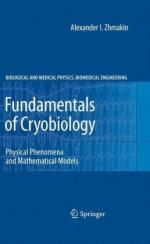|
This section contains 337 words (approx. 2 pages at 300 words per page) |
Cryobiology is the study of the effects of very low temperatures on living things. Temperatures ranging from the freezing point of water down to absolute zero are used to freeze living matter, often to preserve the cells for the future. Usually liquid nitrogen is used to get temperatures down quickly so that cells can be placed in "suspended animation" and then, if quickly thawed, resume their normal activity. When cells are frozen slowly, a great deal of damage occurs because water within the cell crystallizes first, leaving great concentrations of other compounds such as salts, which throws off the delicate osmotic balance. The cells dehydrate and the acid-base balance is destroyed. To avoid cell death, the freezing process is controlled and aided by certain antifreeze agents. Cryobiology techniques are used to freeze and store eye corneas, blood, sperm, and pollen in "banks" for future use. Although currently applicable in human beings only in the realm of science fiction, cryobiologists have conducted studies of freezing entire animals and then "bringing them back to life" an hour or so later. For humans, such cryopreservation could be used, for example, to freeze a person who has a terminal illness in hopes of "unfreezing" them in the future when a cure would be found. In 1961, an American physician, Irving S. Cooper, began using a freezing technique known as cryosurgery to freeze and destroy damaged tissue within the brains of Parkinson's disease patients. His technique destroyed cells that caused some of the symptoms of Parkinson's such as tremors and rigidity. Since that time cryosurgery has been used successfully in delicate eye surgery to remove cataracts from the lens of the eye and repair detached retinas. It has more recently been used in the treatment of liver tumors and prostate and cervix cancer. Cryosurgery is relatively bloodless because the reduced temperatures cause the constriction of blood vessels so there is little bleeding. Special instruments are used with freezing tips which kill unwanted tissue while the healthy tissue around it is shielded.
|
This section contains 337 words (approx. 2 pages at 300 words per page) |


